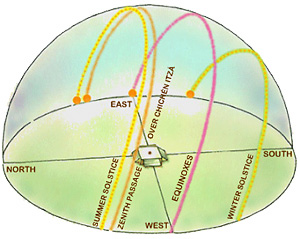|
THE
SUN'S PATH
Solstices,
Equinoxes, and the Zenith Passage
 Throughout
the year, the sun’s path across the sky continually changes.
In summer, the sun is high in the sky, and in winter, the sun is
low in the sky. These changes have a simple cause: The earth’s
axis of rotation is tilted.
Throughout
the year, the sun’s path across the sky continually changes.
In summer, the sun is high in the sky, and in winter, the sun is
low in the sky. These changes have a simple cause: The earth’s
axis of rotation is tilted.
When it’s summer in the Northern Hemisphere, the North Pole
is tilted toward the sun and the sun shines more directly on the
Northern Hemisphere than it does at other times. As the earth spins,
places in the Northern Hemisphere stay in the sunlit area longer,
and that means the days are longer. The longest day of the year
is called the summer solstice (June 21 in the Northern Hemisphere).
When it’s winter in the Northern Hemisphere, the North Pole
is tilted away from the sun, the sun shines the least directly on
the Northern Hemisphere, and the days are shorter. The shortest
day of the year is called the winter solstice (December 21 in the
Northern Hemisphere).
At two points in the earth’s orbit, the North Pole is pointed
neither toward nor away from the sun. These two points, called the
equinoxes, fall about March 21 and September 21. On these two days,
there are equal amounts of daytime and nighttime—12 hours
each—everywhere on earth.
 Once
or twice each year, people who live at lower latitudes (within 23.5
degrees of the equator) can see the sun reach the zenith, an imaginary
point directly overhead. (If you poked a pencil straight into the
ground when the sun was at its zenith, it would make no shadow at
all.) The path the sun takes on these days—from sunrise through
zenith, to sunset—is called the
zenith passage
.
Right at the equator, the zenith passage coincides with the equinoxes.
Once
or twice each year, people who live at lower latitudes (within 23.5
degrees of the equator) can see the sun reach the zenith, an imaginary
point directly overhead. (If you poked a pencil straight into the
ground when the sun was at its zenith, it would make no shadow at
all.) The path the sun takes on these days—from sunrise through
zenith, to sunset—is called the
zenith passage
.
Right at the equator, the zenith passage coincides with the equinoxes.
At
Chichén Itzá, the zenith passage is experienced on
May 26 and July 20, give or take a day. These zenith events apparently
played a key role in the development of the Mayan calendar.
|

 Throughout
the year, the sun’s path across the sky continually changes.
In summer, the sun is high in the sky, and in winter, the sun is
low in the sky. These changes have a simple cause: The earth’s
axis of rotation is tilted.
Throughout
the year, the sun’s path across the sky continually changes.
In summer, the sun is high in the sky, and in winter, the sun is
low in the sky. These changes have a simple cause: The earth’s
axis of rotation is tilted.
 Once
or twice each year, people who live at lower latitudes (within 23.5
degrees of the equator) can see the sun reach the zenith, an imaginary
point directly overhead. (If you poked a pencil straight into the
ground when the sun was at its zenith, it would make no shadow at
all.) The path the sun takes on these days—from sunrise through
zenith, to sunset—is called the
zenith passage
.
Right at the equator, the zenith passage coincides with the equinoxes.
Once
or twice each year, people who live at lower latitudes (within 23.5
degrees of the equator) can see the sun reach the zenith, an imaginary
point directly overhead. (If you poked a pencil straight into the
ground when the sun was at its zenith, it would make no shadow at
all.) The path the sun takes on these days—from sunrise through
zenith, to sunset—is called the
zenith passage
.
Right at the equator, the zenith passage coincides with the equinoxes.